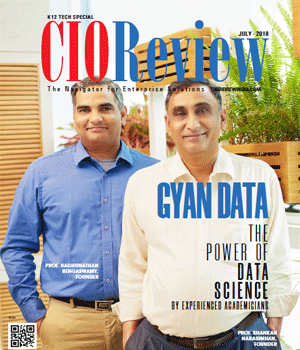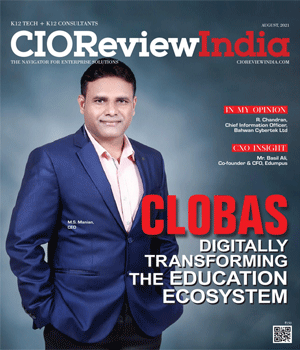
Unleashing The Power Of Analytics In Academics
Leebrian E Gaskins, Associate Vice President IT/CIO, Texas A&M International University | Wednesday, 08 August 2018, 07:11 IST
 Leebrian is a distinguished Associate Vice President of Information Technology/Chief Information Officer with expertise in diverse range of technologies within the higher education industry setting. He has demonstrated success and progressive responsibility in management, budget oversight, and information systems.
Leebrian is a distinguished Associate Vice President of Information Technology/Chief Information Officer with expertise in diverse range of technologies within the higher education industry setting. He has demonstrated success and progressive responsibility in management, budget oversight, and information systems.
Typically, higher education institutions do not have a shortage of academic professionals and researchers who understand how to collect, organize, and analyze data into meaningful and actionable results. One would think that higher education would be on the cutting edge in the use of big data and data science especially in the areas of operational efficiencies and student outcomes such as optimal course scheduling, space utilization, student recruitment, retention, and graduation.
So how does higher education move forward in using data to create better operational efficiencies and student outcomes?
Institutional Challenges
Unfortunately, in most higher education institutions, such use of big data and data science is woefully behind the curve. A significant amount of administrative overhead is dedicated to compliance and control and a significant amount of academic resources is allocated to teaching and scholarly research. Institutions are besieged by accreditors, regulators, and auditors measuring and ensuring compliance with local, state, and federal mandates which capitalized the time and resources of most executive and academic administrators. Coupled with the increased atmosphere and fiscal burden of accountability and compliance, the federal government, many states, and financial donors are significantly cutting funding to higher education forcing institutions to strictly control cost.
An additional hurdle for higher education is disparate data residing in various information systems. The vast collection of data created by students, parents, faculty, and administrators daily interacting with multiple systems across the institution presents challenges. Most of the data exist as fragmented repositories throughout the institution and, in some cases, with third-party vendors or in paper documents. The data that is available in such information systems are static snapshots in time, such as class census day, that usefulness is more in reporting rather than forecasting or intervention.
Most institutions realize these particular challenges and embrace, with trepidation, systems to perform data analytics. Affordability is a concern as such analytical systems require fiscal investment in staff, specialized training, and tools (often software and hardware). Some institutions are hard-pressed to redirect already allocated funds into analytic programs. Such funds are tiedup often in other initiatives and programs and difficult to justify redirecting monies into analytics even with the potential payoffs. This hesitance and postponement of using analytics is counterintuitive given the long-term benefits gleaned from its use.
Also, many institutional researchers, faculty, and administrators who would normally lead analytic efforts are too busy reporting due to the increased accountability standards in higher education. Information technology and institutional research departments are generally overburdened and consigned to the delivery and presentation of results satisfying reporting requirements.
"It is imperative to start small by stringing together a series of small analytical ‘successes’ to build the momentum to ensure your business goes a really long way"
When institutions embrace analytics, there is some confusion on what is meant by “analytics” and “data-driven” decision-making. Analytics, in its broadest sense, is discovering and understanding patterns in data. While analytics is a great discovery exercise, in the beginning of such discovery, organizations need to adhere to Stephen Covey second principle, “begin with the end in mind”. Often, there is not a common definition for analytics in higher education. Business analytics, academic analytics, predictive analytics, action analytics, and learning analytics are batted around without a clear understanding and decision on what is needed and where resources should be focused.
How can today’s CIOs, who are in or those transitioning to higher education, help their institutions move toward the use of analytics?
CIOs’ Role in Using Analytics
CIOs have distinctive experience in implementing expensive information systems. Often, analytical systems are costly in money and time. They require implementation, care, and feeding like other information systems. Executive leadership, in conjunction with the CIO, must commit to the time and cost of implementing an analytics system with the understanding that dividends may not instantly materialize. The CIO can act as a catalyst by creating synergy between data owners, institutional research, and executive leadership.
First, the CIO should evaluate the capabilities of the resources at hard. Given the burdens of reporting and compliance, can the staff in various areas of the organization manage the additional workload required by an analytic system or should some outside entity be enlisted? High-quality data from multiple sources must be fed into the system in order to receive high-quality actionable analytics. While access and collection of data may be a manageable hurdle, the staff will need to continuously refine their skills and tools. If the decision is made to go with an external entity, there are a few outside advisory boards that specialize in data analytics and best practices in the areas of enrollment management, student success, and academic operations. The CIO must engage the external entity on data security, project milestones, and deliverables.

Once an analytic system has been chosen and implementation has begun, the CIO must work with senior leadership to create a culture of using data to drive decisions. The organization moves from collecting and analyzing to action. Senior leadership must pledge to use, after careful review and discussion, the results of the analysis regardless of how favorable or unfavorable.
Today’s CIOs are in a unique position to provide leadership and guidance in the better use of data in decision-making in higher education. Analytic programs, those which use data to make informed decisions, are most successful when information technology (IT) and institutional research (IR) work in conjunction with executive leadership.
CIO Viewpoint
The Future's Bright, The Future's Digital
By Jon Wrennall, CTO, UK&I, Fujitsu
By David Behen, DTMB Director & State CIO, State of Michigan
CIOs Need To Know Their Business - Not Just Tech
By John Sadowski, EVP & CIO, Sandy Spring Bank
CXO Insights
How Edtech Companies Are Redefining The...
By Mr. Arunprasad Durairaj, CEO & Co-founder, Flintoclass@HOME
How AI-Focused Start-Ups Can Transform Student...
By Mr. Basil Ali, Co-founder & CFO, Edumpus
Challenges And Issues Of Online Classes








